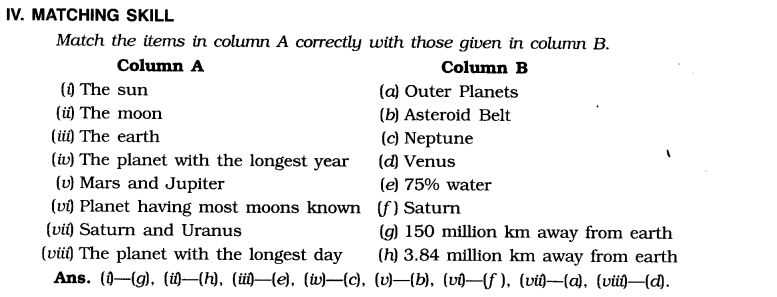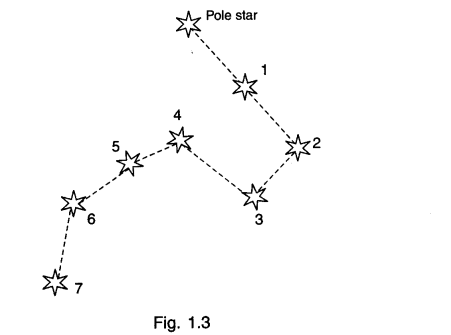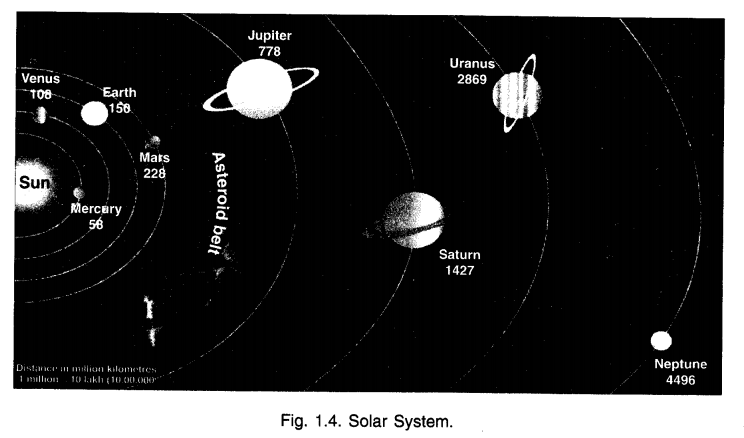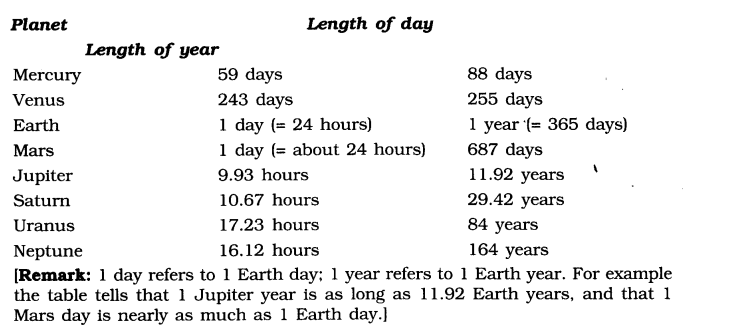Class 6 Social Science Geography Chapter 1 The Earth in the Solar System NCERT Solutions
1. Answer the following questions briefly.
(a) How does a planet differ from a star?
(b) What is meant by the ‘Solar System’?
(c) Name all the planets according to their distance from the sun.
(d) Why is the Earth called a unique planet?
(e) Why do we see only one side of the moon always?
(f) What is the Universe?
Answer: (a) Differences between a planet and a star:
(b) The term Solar System refers to the “family” of the Sun. The Sun is a star around which eight planets, among other celestial objects, revolve in orbits. This whole system of bodies is called the Solar System. The Sun is the “head” of this system.
(c) The list of planets in the order of their distance from the Sun is as follows:
- Mercury
- Venus
- Earth
- Mars
- Jupiter
- Saturn
- Uranus
- Neptune
(d) The Earth is regarded as a unique planet because of the following reasons:
- It is the only planet known to support life. It has oxygen and water present in proportions that allow life to thrive.
- It also has a temperature range that supports life.
- The proportion of water present is about two-thirds of the surface of the earth when compared to land.
(e) One revolution of the moon around the earth takes about 27 days. Incidentally, the moon’s rotation about its own axis also takes nearly the same time. One day of the moon is equal to 27 Earth days. So only one side of the moon can be seen from the earth.
(f) The Universe is the largest unit in which we live. It is a collection of galaxies. There is only one Universe and everything that exists in this Universe itself.
2. Tick the correct answer.
(a) The planet is known as the “Earth’s Twin” is
(i) Jupiter
(ii) Saturn
(iii) Venus.
(b) Which is the third nearest planet to the sun?
(i) Venus
(ii) Earth
(iii) Mercury.
(c) All the planets move around the sun in a
(i) Circular path
(ii) Rectangular path
(iii) Elongated path
(d) The Pole Star indicates the direction to the
(i) South
(ii) North
(iii) East.
(e) Asteroids are found between the orbits of
(i) Saturn and Jupiter
(ii) Mars and Jupiter
(iii) The Earth and Mars.
Answers: (a)—(iii), (b)—(ii), (c)—(iii), (d)—(ii), (e)—(ii).
3. Fill in the blanks.
- A group of…….. forming various patterns is called a ………….
- A huge system of stars is called ……………
- ……….. is the closest celestial body to our earth.
- ………. is the third nearest planet to the sun.
- Planets do not have their own ………… and ……….
Answers:
- stars, constellation
- galaxy
- The moon
- The earth
- heat, light.
NCERT Solutions for Class 6 Social Science Geography Chapter 1 Multiple Choice Questions
Choose the correct option to complete the statements given below:
(i) Full moon night occurs once every……….
(a) day
(b) 15 days
(c) 20 days
(d) month.
(ii) The Hindi word for the New Moon night is ……….
(a) Amavasya
(b) Krishna Paksha
(c) Poornima
(d) none of these.
(iii) The sun is …………
(a) a star
(b) a celestial body
(c) the head of the solar system
(d) all of these.
(iv) Ursa Major is a/an
(a) star
(b) constellation
(c) galaxy
(d) asteroid.
(v) Which of these was a planet till 2006 but is now a “dwarf planet”?
(a) Neptune
(b) The Sun
(c) Pluto
(d) Solaris.
(vi) The term “Blue Planet” indicates the presence of
(a) land
(b) water
(c) oxygen
(d) all of these.
Answers:
(i)—(d),
(ii)—(a),
(iii)—(d),
(iv)—(b),
(v)—(c),
(vi)—(b).
Fill in the Blanks.
Fill in the blanks with appropriate words to complete each sentence:
- The Amavasya night occurs about ……….. days after the Poomima night.
- Stars are celestial bodies that are ……….. and ………….
- The planets do not possess their own ……….. and …………
- The Small Bear constellation is better known as the ………….
- The Greek word which is the origin of the word “planets” means ………….
- Three planets having rings around them are …………, ………., and …………
- …….. are elongated fixed paths in which a celestial body always remains.
- Venus is similar to the earth in its ………. and ………….
- The shadows on the moon’s surface are due to ……….., ………, and …………
- Meteoroids heat up and bum due to …………
Answers:
- fifteen
- big, hot
- heat, light
- Saptarishi
- wanderers,
- Jupiter, Saturn, Uranus
- Orbits
- size, shape
- mountains, plains, depressions
- friction.
True/False:
State whether these sentences are true (T) or false (F).
- The Sun appears bigger and brighter than the other stars because it is indeed so.
- Saptarishi and Ursa Major are two different constellations.
- The Pole Star is known to have a fixed position in the sky.
- The earth is the only planet that has a natural satellite.
- Pluto was declared a “dwarf planet” in August 2006.
- The earth is the third-largest planet in the solar system.
- The geoid shape is not perfectly spherical.
- The moon takes about the same time in rotating about its axis once as it does to complete a revolution around the earth.
Answers:
- False
- False
- True
- False
- True
- False
- True
- True.

Class 6th Geography NCERT Chapter 1 Very Short Answer Type Questions
1. Name two celestial bodies visible only in the night sky.
Answer: The moon and the stars are celestial bodies visible in the night sky.
2. Why do we not feel the heat and light of the stars, even though they are so big and hot?
Answer: We do not feel the heat and light of the stars since they are very far away.
3. From which Greek word is the word ‘planet’ derived?
Answer: The word ‘planet’ is derived from the Greek word ‘Planetai’.
4. What does the solar family consist of? [V. Imp.]
Answer: The solar family consists of the sun, planets, their satellites, and asteroids and meteoroids.
5. What is the shape of the orbits in which planets revolve around the sun?
Answer: The orbits of planets are elliptical (Le. elongated) in shape.
6. Which planet is called “Earth’s twin” and why?
Answer: Venus is called “Earth’s twin” because it is similar to Earth in its shape and size.
7. What is “Geoid”?
Answer: A sphere with its ends flattened at poles (just like earth) is called the geoid.
8. Why is earth called “blue planet”? [V. Imp.]
Answer: Earth appears blue from when seen from the outer space since it has over 2/3rd water. So it is called the blue planet.
9. How much time does the moon take to revolve once around the earth?
Answer: The moon takes approximately 27 days to revolve once around the earth.
10. What is the difference between the moon and INSAT? [V. Imp.]
Answer: The moon is a natural satellite of the earth while INSAT is an artificial satellite.
11. What are asteroids?
Answer: Asteroids are the numerous tiny celestial bodies which revolve around the sun and are mainly found between the orbits of Mars and Jupiter.
12. What is a meteoroid?
Answer: Small pieces of rocks which move around the sun are called meteoroids.
The Earth In The Solar System Class 6 Chapter 1 Short Answer Type Questions
1. Name the two extreme shapes of the moon. When and at what intervals do they occur?
Answer: The moon is seen in its two extreme shapes on the Full Moon night arid the New Moon night. The Full Moon. The Full Moon means the moon in its full circular shape. The New Moon. The New Moon means the moon that can not be a seer. The New Moon occurs on the fifteenth day and the Full Moon occurs on the last day of the Hindi calendar month.
2. What is the Pole Star? How can the Saptarishi be used to locate it? [Imp.]
Answer: The Pole Star is the star that is known to retain its position in the sky always. We can locate the position of the Pole Star with the help of the constellation Saptarishi. If an imaginary line is drawn joining the “pointer stars” of the Saptarishi and extended further, it will point to the Pole Star.
In the Fig. 1.3 shown here, 1 and 2 represent the “pointer stars”. The Pole Star and the pointer stars lie on the same line.
3. Write a short note on the two planets nearest to the sun.
Answer: Mercury. It is the nearest planet to the sun. It takes just about 88 earth days to revolve once around the sun. It is extremely hot since it is close to the sun. It is also the smallest planet. Venus. It is the second closest planet to the sun. It is similar to earth in shape and size. It is called “Earth’s twin”.
4. How does earth support life? [V. Imp.]
Answer: The earth has conditions that support life. It is neither too hot nor too cold. It has both water and air, which are both indispensable for life. Presence of oxygen in the air in an appropriate proportion supports life. These factors make the earth a unique planet.
Class 6 Geography Chapter 1 Long Answer Type Questions
1. Write short notes on the following:
(a) The sun
(b) The moon
(c) Galaxy. [V. Imp.]
Answer:
(a) The sun is considered the “head” of the solar system. It is a star, although it is smaller and less bright than most other stars. It is a huge celestial body made up of extremely hot gases. It provides heat and light for the whole of the solar system. Life on earth depends on many factors, and the sunlight is one of them. The sun is about 150 million kilometers away from the earth.
(b) The moon is the only natural satellite of our planet earth. Its diameter is just about a quarter of the earth’s diameter. It is comparatively closer (3,84,400 kilometers away) to earth than all other celestial bodies. It does not support life. It revolves around the earth and rotates about its own axis in about the same time, due to which only one side of the moon is visible to us.
(c) Galaxy is a term that refers to billions of stars, clouds of dust and gases, and other celestial bodies considered as a single unit. The only bigger unit in the universe, galaxies make up the universe. The galaxy we live in is called the Milky Way.
2. Draw a diagram showing the eight planets of the solar system in their orbits around the’ sun. Also prepare a table mentioning the length of their days and years.
Answer:

.png)
.png)